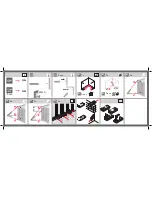
Ro-20 RB-XXX-XXXXXX
E
3-1
Löw 08.10.2008
3. Theory of Operation
3.1
General Theory
Figure 3-1
and
Figure 3-2
show the basic operation of the circuit. The ion chamber structure is
maintained at chassis potential while all the other circuitry is held at –36 volts by the 3 ea 12-
volt bias batteries. When the air in the chamber ionizes due to radiation, a minute current
flows from the chamber wall to the center electrode, causing the minus input lead of the first
operational amplifier to go very slightly positive. This change results in a negative swing of
the amplifier output, which is connected to the feedback elements through a temperature-
compensating divider circuit.
The feedback elements are connected to the amplifier input and to the ion chamber, and they
conduct away all of the current generated in the ion chamber. The second amplifier stage,
which is fed from the first amplifier, drives the meter through calibrating adjustable resistors.
The gain of the second stage is controlled by the Function Switch so that the full scale output
from the second stage is nearly constant for all ranges.
A common line is used as a reference for all the electronic circuits. This common line is held
approximately 36 volts negative with respect to the instrument chassis.
Figure 3-1: Connector board component layout
Summary of Contents for RO-20
Page 1: ...Operating Manual RF 000 xxxxxx RO 20 AA Ion Chamber ...
Page 2: ......
Page 22: ......
Page 30: ...4 8 RB XXX XXXXXX E RO 20 Löw 08 10 2008 ...
Page 31: ...Ro 20 RB XXX XXXXXX E 4 9 Löw 08 10 2008 Figure 4 2 General schematic ...
Page 32: ......
Page 35: ...Meßnetzprogramm NetView RF 019 950313 Schl Ff 13 03 1995 SACHWORT REGISTER ...
Page 36: ......















































